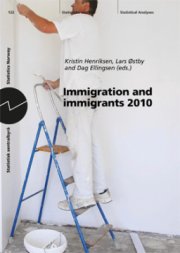Statistical analyses 122
Immigration and immigrants 2010
This publication deals with the scope of immigration to Norway, and the living conditions of immigrants and Norwegian-born to immigrant parents.
This publication deals with the scope of immigration to Norway, and the living conditions of immigrants and Norwegian-born to immigrant parents. By comparing the living conditions of immigrants and non-immigrants, and examining long-term trends for immigrants, a picture can also be formed of integration, and how this develops. The publication is largely based on corresponding publications in 2002, 2004, 2006 and 2008. When creating such a collection of publications on immigrants and Norwegian-born to immigrant parents, it is important to remember that this group is the most heterogeneous group in social statistics. At the start of 2010, the immigrant population in Norway was made up of immigrants from no less than 215 countries and autonomous regions. Living conditions vary with age, gender, level of education and social background. The living conditions of immigrants are additionally affected by factors such as country of origin, their reason for immigrating to Norway, age at immigration and length of stay in Norway.
The analysis first describes the population structure by country background, gender, age etc. Population changes through immigration, emigration and population growth are then described. Finally, the reasons for immigration are explained. One important feature is the recent increase in labour immigration, only slightly affected by the financial crisis. How long the large influx from Central and Eastern Europe and Sweden will continue is not known, and the question of what will eventually happen with regard to family immigration or return migration remains unanswered.
We examine immigrants and Norwegian-born to immigrant parents’ path through the education system. We consider the scope of language-stimulating initiatives that are implemented at kindergarten, language teaching in primary and lower secondary schools, and immigrants’ participation and completion rate at upper secondary schools and in higher education. Immigrants and Norwegian-born to immigrant parents generally have poorer results in their compulsory schooling than other pupils. However, it should be noted that increasing numbers of Norwegian-born to immigrant parents are going on to higher education, and that, on average, this group now has a much higher rate of participation than other adolescents in Norway.
The labour market and education are considered to be the most important arenas for the integration of immigrants. The analysis describes differences in employment levels among men and women by country background and length of stay in Norway. We also examine the employment among Norwegian- born to immigrant parents. A major increase in employment is found among immigrants up until 2008, after which a certain decline is observed. However, the gap with the rest of the population is less than pre-2005. The increase in unemployment due to the financial crisis was particularly applicable to immigrants from the new EEA member countries (such as Poland), and was perhaps just as much a reflection of the employment problems in the building and construction industry as of immigrants’ problems in the labour market.
We also look at incomes and the low-income group share in different immigrant groups, and particularly long-term low incomes. Many immigrant children grow up in families with a low income, and this situation often persists for a long period of time.
Norwegian attitudes to immigration and immigrants in the period 2001-2009 are relatively stable, but are partly influenced by fluctuations in the economy.
The analysis includes comparative data on European attitudes to immigrants. Norwegians are one of the most liberal groups in Europe, but the Swedes are far more liberal than us in relation to almost all areas of immigration. The analysis concludes with an overview of the data used for immigrant-related statistics, and presents a comprehensive overview of other immigrant-related statistics and analyses published by Statistics Norway.
About the publication
- Title
-
Immigration and immigrants 2010
- Authors
-
Kristin Henriksen, Lars Østby, Dag Ellingsen
- Series and number
-
Statistical analyses 122
- Publisher
-
Statistisk sentralbyrå
- Cover design
-
Siri E. Boquist
- Topics
-
Living conditions , Immigrants , Population, Social conditions, welfare and crime
- ISBN (online)
-
978-82-537-8094-8
- ISSN
-
1892-7521
- Number of pages
-
180
- Language
-
English
- About Statistical analyses
-
In this series, Statistics Norway publishes analyses of social, demographic and economic statistics, aimed at a wider circle of readers. These publications can be read without any special knowledge of statistics and statistical methods.
Contact
-
Statistics Norway's Information Centre

